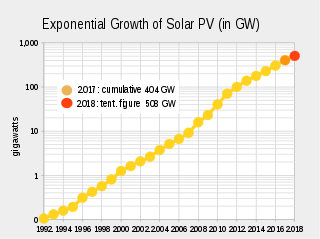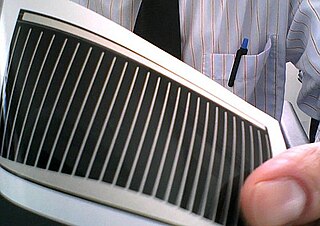
Photovoltaics (PV) is the conversion of light into electricity using semiconducting materials that exhibit the photovoltaic effect, a phenomenon studied in physics, photochemistry, and electrochemistry. The photovoltaic effect is commercially utilized for electricity generation and as photosensors.

Copper indium gallium (di)selenide (CIGS) is a I-III-VI2 semiconductor material composed of copper, indium, gallium, and selenium. The material is a solid solution of copper indium selenide (often abbreviated "CIS") and copper gallium selenide. It has a chemical formula of CuIn(1-x)Ga(x)Se2 where the value of x can vary from 0 (pure copper indium selenide) to 1 (pure copper gallium selenide). CIGS is a tetrahedrally bonded semiconductor, with the chalcopyrite crystal structure, and a bandgap varying continuously with x from about 1.0 eV (for copper indium selenide) to about 1.7 eV (for copper gallium selenide).

A solar cell panel, solar electric panel, photo-voltaic (PV) module or just solar panel is an assembly of photo-voltaic cells mounted in a framework for installation. Solar panels use sunlight as a source of energy to generate direct current electricity. A collection of PV modules is called a PV panel, and a system of PV panels is called an array. Arrays of a photovoltaic system supply solar electricity to electrical equipment.
Nanosolar was a developer of solar power technology. Based in San Jose, CA, Nanosolar developed and briefly commercialized a low-cost printable solar cell manufacturing process. The company started selling thin-film CIGS panels mid-December 2007, and planned to sell them at 99 cents per watt, much below the market at the time. However, prices for solar panels made of crystalline silicon declined significantly during the following years, reducing most of Nanosolar's cost advantage. By February 2013 Nanosolar had laid off 75% of its work force. Nanosolar began auctioning off its equipment in August 2013. Co-Founder of Nanosolar Martin Roscheisen stated on his personal blog that nanosolar "ultimately failed commercially." and that he would not enter this industry again because of slow-development cycle, complex production problems and the impact of cheap Chinese solar power production. Nanosolar ultimately produced less than 50 MW of solar power capacity despite having raised more than $400 million in investment.

Building-integrated photovoltaics (BIPV) are photovoltaic materials that are used to replace conventional building materials in parts of the building envelope such as the roof, skylights, or facades. They are increasingly being incorporated into the construction of new buildings as a principal or ancillary source of electrical power, although existing buildings may be retrofitted with similar technology. The advantage of integrated photovoltaics over more common non-integrated systems is that the initial cost can be offset by reducing the amount spent on building materials and labor that would normally be used to construct the part of the building that the BIPV modules replace. In addition, BIPV allows for more widespread solar adoption when the building's aesthetics matter and traditional rack-mounted solar panels would disrupt the intended look of the building. These advantages make BIPV one of the fastest growing segments of the photovoltaic industry.
HelioVolt Corporation was a privately held U.S. solar energy company based in Austin, Texas, that suspended operations in 2014. The company manufactured photovoltaic (PV) solar modules using a thin film semiconductor process based on copper indium gallium selenide (CIGS) to produce CIGS solar cells. HelioVolt manufactured these thin film modules for commercial rooftop, utility-scale ground mount, residential, building-integrated photovoltaics (BIPV) and custom installations. The company raised over $230 million in investment, including over $80 million by SK Group.
MiaSolé is an American solar energy company selling copper indium gallium selenide (CIGS) thin-film photovoltaic products. MiaSolé's manufacturing process lays CIGS on a flexible stainless steel substrate. MiaSolé produces all layers of photovoltaic material in a continuous sputtering process.
Global Solar Energy is a US-based manufacturer of CIGS solar cells, a thin-film based photovoltaic technology, with manufacturing operations in Tucson, Arizona, United States, and Berlin, Germany. In 2013, it was bought by Chinese renewable energy company Hanergy.

Ascent Solar Technologies, Inc. is a publicly traded photovoltaic (PV) company located in Thornton, Colorado. Its primary product is a flexible CIGS solar cell on a plastic substrate.

Cadmium telluride (CdTe) photovoltaics describes a photovoltaic (PV) technology that is based on the use of cadmium telluride in a thin semiconductor layer designed to absorb and convert sunlight into electricity. Cadmium telluride PV is the only thin film technology with lower costs than conventional solar cells made of crystalline silicon in multi-kilowatt systems.
German company Sulfurcell was founded in 2001 in Berlin for developing and producing thin film solar cells based on copper indium sulfide (CIS) technology. The venture capital backed company was voted sixth on the 2008 inaugural Guardian/Library House "CleanTech 100" list, which showcased the best in European clean technology companies. The company was renamed into Soltecture in 2009. On 09 May 2012, Soltecture went into administration.

A thin-film solar cell is a second generation solar cell that is made by depositing one or more thin layers, or thin film (TF) of photovoltaic material on a substrate, such as glass, plastic or metal. Thin-film solar cells are commercially used in several technologies, including cadmium telluride (CdTe), copper indium gallium diselenide (CIGS), and amorphous thin-film silicon.

Worldwide growth of photovoltaics has been close to exponential between 1992 and 2018. During this period of time, photovoltaics (PV), also known as solar PV, evolved from a niche market of small-scale applications to a mainstream electricity source.

A copper indium gallium selenide solar cell is a thin-film solar cell used to convert sunlight into electric power. It is manufactured by depositing a thin layer of copper, indium, gallium and selenium on glass or plastic backing, along with electrodes on the front and back to collect current. Because the material has a high absorption coefficient and strongly absorbs sunlight, a much thinner film is required than of other semiconductor materials.

Solar Frontier Kabushiki Kaisha is a Japanese photovoltaic company that develops and manufactures thin film solar cells using CIGS technology. It is a fully owned subsidiary of Showa Shell Sekiyu and located in Minato, Tokyo, Japan. The company was founded in 2006 as Showa Shell Solar, and renamed Solar Frontier in April 2010.
Hanergy Holding Group Ltd. (Hanergy) is a Chinese multinational company headquartered in Beijing. The company is focusing on thin-film solar value chain, including manufacturing and solar parks development. It also owns the Jinanqiao Hydroelectric Power Station and two wind farms.
Siva Power, Inc. is an American solar power company that develops thin-film technology. The company designs and manufactures copper indium gallium deselenide (CIGS) photovoltaics. Siva Power is based in San Jose, California. Bruce Sohn is CEO and Mark Heising is Chairman.
Flisom is a developer and manufacturer of photovoltaic (PV) thin film solar cells, located near Zurich, Switzerland. The company produces high-efficiency CIGS thin film solar modules on flexible plastic foil using proprietary roll-to-roll manufacturing techniques.








